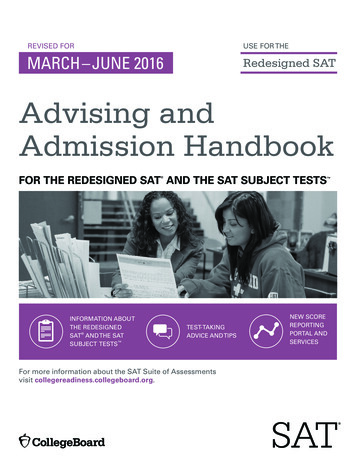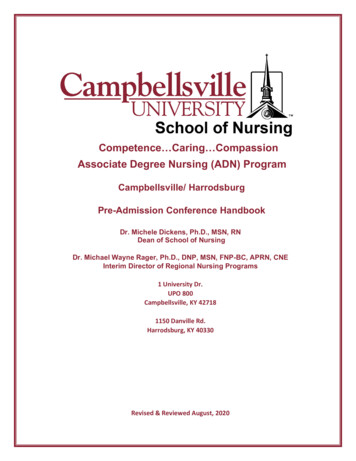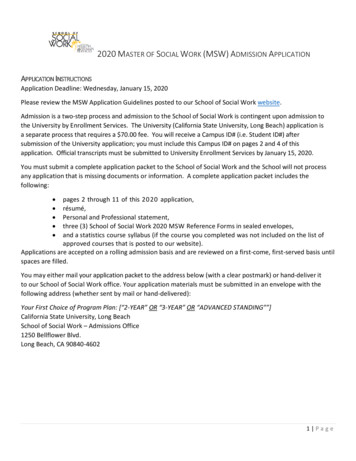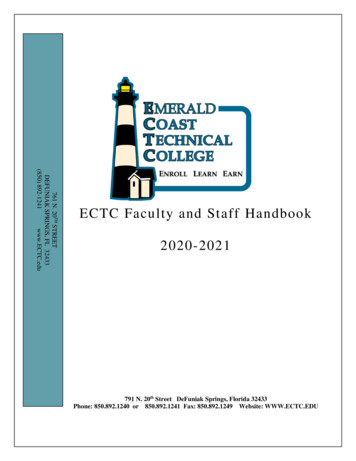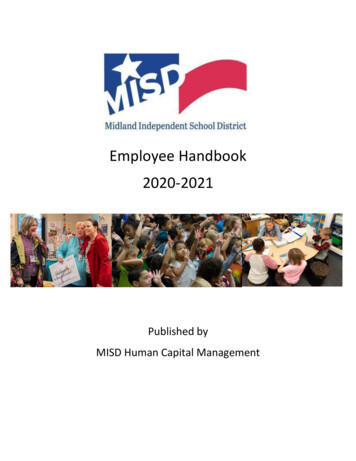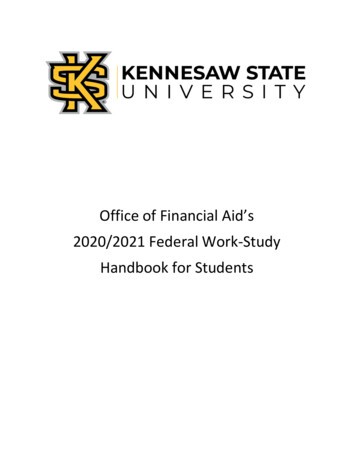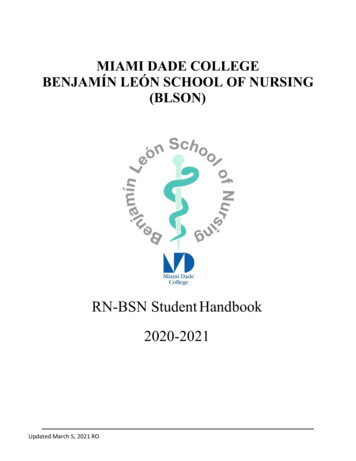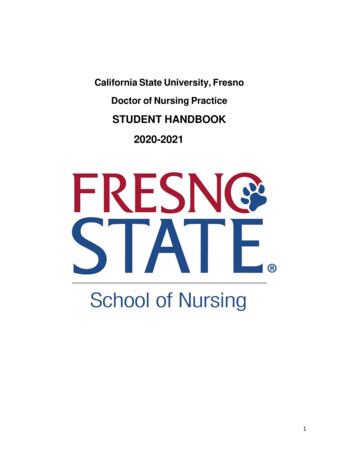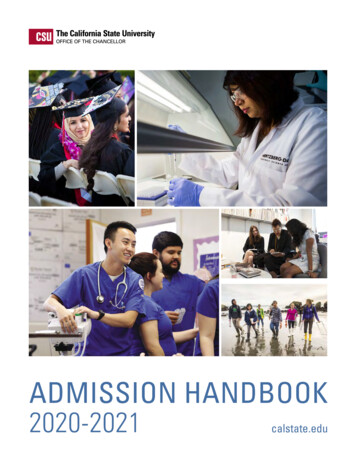
Transcription
ADMISSION HANDBOOK2020-2021calstate.edu
The CSU Admission Handbookis published byStudent Affairs & Enrollment Management,a department of Academic and Student AffairsThe California State University, Office of the Chancellor401 Golden ShoreLong Beach, CA 90802September 2019www.calstate.edu
INTRODUCTIONSince the founding of the first state college in San José in 1857, the California StateUniversity (CSU) has continued to respond to the demands of new generations of Californiansseeking a quality education. The CSU is committed not only to access but also to the successof students admitted to the university. CSU campuses sponsor programs for low-incomestudents who are California residents and have been disadvantaged and underservedbecause of their economic and/ or educational backgrounds. These programs include servicessuch as academic advising, counseling and learning assistance.CSU campuses offer a full-range of outstanding baccalaureate degree programs for enteringand transfer students as well as honors programs for students who seek a more rigorousprogram of academic challenge. Recognizing that preparation is the most important variableaffecting university eligibility, the CSU supports efforts to enrich the academic experienceof students at both the secondary and post-secondary levels. While each campus has itsown unique geographic, cultural and curricular character, all campuses are multipurposeinstitutions and offer undergraduate and graduate instruction for professional andoccupational goals as well as a broad liberal education. Students are encouraged to exploreeducational options at the CSU through Cal State Apply (www.calstate.edu/apply).This publication presents systemwide policies that apply to all CSU campuses. Applicantsand counselors can expect common undergraduate admission standards to be appliedthroughout the CSU, except for impacted majors and campuses. In addition to rules thatincorporate regulations concerning admission and demonstration of competency in writtencomposition and mathematics/quantitative reasoning, this booklet includes definitionsof commonly used terms. Further information about distinctive campus programs andrequirements can be found in the respective campus catalogs and/or websites.This booklet is primarily intended for high school and community college counselorsresponsible for advising students who are college-bound, and for CSU admission evaluatorsand admission officers who interpret documents submitted in support of admissionapplications. Included are details pertaining to subject requirements and performance criteriarequired to establish eligibility for admission to the CSU at all undergraduate levels: firsttime freshmen, lower-division transfers and upper-division transfers. Students interested ingraduate studies should visit the respective CSU campus websites.Admission information specific to an academic year is available electronically through CalState Apply. Applicants are expected to access www.calstate.edu/apply before applying foradmission to the CSU.2020-2021 ADMISSION HANDBOOK3
Information Sources. 6Table ofContents”a-g” Course List. 6Application Dates and Deadlines. 6Articulation System Stimulating Inter-institutionalStudent Transfer (ASSIST). 6Calstate.edu. 6California Colleges. 7California Dream Application. 7Cal State Apply. 7CSU Degrees/Majors Search. 7English Success. 7Free Application for Federal Student Aid (FAFSA). 7Mathematics Success. 7First-Time Freshmen:Admission Requirements. 8Minimum Eligibility Index. 9Test Score Requirement. 9Multiple Test Scores. 9Provisional Admission. 9Admission Exceptions. 10Homeschooling. 11“a-g” Subjects. 11History/Social Science. 11English. 12English as a Second Language. 12Mathematics. 12Science. 12Language Other Than English. 12Documentation of Language. 14Assessment of Language Skills. 15American Sign Language. 16Visual and Performing Arts. 16Electives. 17Year-sequence Course. 18Multiple-year Courses. 18Subject Requirement Substitution for Studentswith Disabilities. 18SAT Eligibility Index for California High School Graduates orResidents of CA. 19SAT Eligibility Index for Non-CA Residents or Non-Graduates of CA. 2042020-2021 ADMISSION HANDBOOK
ACT Eligibility Index for California High School Graduates orResidents of CA. 21Articulation. 40ACT Eligibility Index for Non-CA Residents or Non-Graduates of CA. 22Certification of American Institutions Requirement. 41High School Grade Point Average (GPA). 23Transcripts and Verification of Eligibility. 41Honors Courses. 22Planning Effectively for Transfer from CCC to CSU. 42Advanced Placement/Standing (AP). 23Apply Online for Transfers. 43Baccalaureate Credit. 25Orientation and Early Registration. 43International Baccalaureate Courses (IB). 25Certification of Completion of General Education Requirements. 41College-Level Examination Program (CLEP). 25Campus and Program Impaction. 44High School Graduation Equivalency. 25Supplemental Admission Criteria. 44High School Student Checklist. 26Major/Program Impaction. 44Apply Online for First-Time Freshmen. 26Campus Impaction. 45Financial Aid and Financial Planning Activities. 26Other Programs and Services. 46Orientation and Early Registration. 26Fee Waivers and Exemptions. 26Services to Students with Disabilities. 27Immunization Requirements. 27First-Time Freshmen:Placement Requirements. 28Placement Measures for First-Year GE Courses. 28Existing Skills Assessments for GE Written Communication. 28Educational Opportunity Program (EOP). 46Foster Youth Programs. 46Basic Needs Initiative. 46California’s Cross Enrollment Program. 47California Promise. 47Residency at the CSU. 48Determination of Residency for Tuition Purposes. 48Establishing Residency. 48Existing Skills Assessments for GE Mathematics/Quantitative Reasoning. 30Residency Determination Dates. 48Early Start Program. 32Basis for Appeal. 50The English Language Standard. 34English Language Examination. 34Preparing to Transfer to the CSU. 36Admission Priority. 36Transfer Credit. 36Upper-Division Transfer Admission Requirements. 36Lower-Division Transfer Admission Requirements. 37Appeal of Residency Classification. 49Final Determination. 50Changes of Residency. 50Glossary. 52Frequently Asked Questions. 56Nondiscrimination Policy. 60Campus Information. 62Associate Degree for Transfer: A Pathway to a CSU Degree. 37Transfer Admission Requirements for theAssociate Degree for Transfer. 37Transfer – General Education Course Requirements. 38Transfer – General Education Options. 38General Education Breadth Requirements. 38Intersegmental General Education Transfer Curriculum (IGETC). 38Transfer Grade Point Average (GPA). 392020-2021 ADMISSION HANDBOOK5
“a-g” Course .edu/agcourselist#/list/search/institutionThis website allows an individual to search for a California highschool or program’s UC-certified course list. The lists includecourses that have been certified as fulfilling the “a-g” subjectrequirements for freshman admission to the UC and CSU. Thelists also indicate courses that are UC certified honors courses.Application Dates & DeadlinesThe CSU provides information regarding the application datesand deadlines for each campus by student level, major andprogram. Please visit www.calstate.edu/apply and clickon “See Application Dates and Deadlines” to view the latestinformation on whether a specific campus, major or programaccepts applications. The website is updated regularly and is aconvenient location to determine which CSU campuses continueto accept admission applications after the initial filing period.ASSIST (Articulation SystemStimulating Inter-institutionalStudent Transfer)www.assist.orgASSIST is California’s official statewide repository of coursearticulation information. ASSIST can help California CommunityCollege students determine if they will receive credit for coursesthey have already taken and how those courses will apply tospecific academic goals.Calstate.eduThe CSU provides systemwide information on admission,impaction, enrollment, early assessment, educational opportunity,outreach, community service learning, degrees offered, extendeduniversity, fellowships, financial aid, international programs, feesand summer arts programs. The Chancellor’s Office descriptionsof educational programs, systemwide policies and initiatives,historical and general information, admission requirementsand procedures, and news releases are centrally located here.The 23 CSU campus websites are sources of information forstudents and counselors. All campus websites are linked fromwww.calstate.edu and can be viewed by selecting your choiceof campus(es) from the homepage.62020-2021 ADMISSION HANDBOOK
California CollegesCSU Student success.orgCaliforniaColleges.edu is an interactive, web-based platformwith an embedded curriculum that guides students througha series of developmentally appropriate college and careerplanning activities. Students who use CaliforniaColleges.educan link their account to Cal State Apply and import coursesfrom the Academic Planner into their application. Students inCalifornia College Guidance Initiative (CCGI) partner districtsare strongly encouraged to link their accounts so their preverified transcript data moves to Cal State Apply, streamliningthe application process. For a list of CCGI partner districts, -Partners.The English Success website provides information andadvice to help students get ready for college-level writtencommunication courses.California Dream ApplicationThrough this website, students can determine eligibility, gatherdocuments and information, check deadlines and apply online.FAFSA (Free Application forFederal Student Aid)www.fafsa.govFAFSA provides access to the federal student aid process. TheFAFSA is available beginning October 1, 2019, to apply for thefall 2020 admission cycle. Students will need to use their and/ortheir parents 2018 income data and tax returns.https://dream.csac.ca.govThe California Dream Application is available beginning October1, 2019, to apply for the fall 2020 admission cycle. Students willneed to use their and/or their parents 2018 income data andtax returns. The California Dream Application is the applicationfor state and institutional financial aid for students who arewithout lawful permanent residency status. AB 540 is thename of California legislation that enables these students to beconsidered residents for tuition purposes. AB 540 students whoare U.S. citizens or permanent residents should use the FAFSAto apply for financial aid. Dependent students should have theirparents’ financial information ready when applying. For moreinformation on AB 540 requirements and the Dream application,please visit www.csac.ca.gov/dream act.asp.Cal State Applywww.calstate.edu/applyThe central CSU application has been completely redesigned toprovide applicants with a dynamic experience when applying foradmission. The new application allows applicants to access thesite from a variety of devices and allows applicants to apply tomultiple campuses with one single application.CSU Degrees/Majors s website enables applicants to search for undergraduate,masters and doctoral programs available at all CSU campuses.2020-2021 ADMISSION HANDBOOK7
First-TimeFreshmen:AdmissionRequirementsThe CSU draws its students from the top one-third of California’shigh school graduates, with first-time freshmen comprising anaverage of approximately 40 percent of the overall enrollmenteach year.A freshman applicant is a student who has graduatedfrom (or is still in) high school and who has not enrolledin a regular (non-summer) session at any college oruniversity following graduation. First-time freshmanapplicants must: Graduate from high school or equivalent.Although regulations do not stipulate graduation fromaccredited high schools, the CSU participates in theactivities of the Western Association of Schools andColleges and its Accrediting Commission for Schools andencourages California high schools to be accredited by theAssociation. Students who are homeschooled or attendnon-accredited schools are expected to meet the sameadmission requirements as graduates of accredited highschools. Complete the 15-unit comprehensive “a-g” coursepattern of college preparatory study with grades of Cor better* by high school graduation. These coursesmay not be taken as pass/fail or credit/no credit.For purposes of admission, the CSU faculty has delegatedto the University of California (UC) the responsibility forthe process of certifying high school courses that meetthe “a-g” requirement. Consequently, the CSU acceptshigh school courses on the UC “a-g” course list. Courseson the “a-g” list can be used to meet CSU requirements inthe designated subject areas or may be used as electives.Under the “High School Coursework” section in theadmission application, first-time freshman applicants mustreport all approved college preparatory “a-g” courses thathave been completed, courses in which they are currentlyenrolled and courses that they plan to complete prior toentrance into the CSU. Courses completed in summerschool should be included.CSU campuses seek to enroll well-prepared freshmenwho have completed the 15-unit “a-g” college preparatorycourse pattern.Completion of the 15-unit “a-g” requirement is animportant step in qualifying for admission to any CSUprogram. Applicants for freshman admission to the CSUare encouraged to complete rigorous coursework thatwill prepare them for success at the university and in theworkforce. For many students, the completion of rigorous82020-2021 ADMISSION HANDBOOK
and demanding career and technical education (CTE) coursescan help accomplish both of these important objectives.Over 12,000 CTE courses are included in the “a-g” courselist at https://hs-articulation.ucop.edu/agcourselist. Thereare often CTE courses that can be used to meet one ormore of the “a-g” categories. Through
The California State University, Office of the Chancellor 401 Golden Shore Long Beach, CA 90802 September 2019 www.calstate.edu. INTRODUCTION Since the founding of the first state college in San José in 1857, the California State University (CSU) has continued to respond to the demands of new generations of CaliforniansFile Size: 3MB


